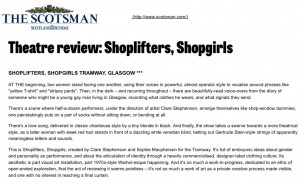SOPHIE MACPHERSON
These are the possibilities of Man as Dancer, transformed through costume and moving in space. Yet there is no costume which can suspend the primary limitation of the human form: the law of gravity, to which it is subject. A step is not much longer than a yard, a leap not much higher than two. The center of gravity can be abandoned only momentarily. And only for a second can it endure in a position essentially alien to its natural one, such as a horizontal hovering and soaring.”
In a small studio, hardly big enough to swing a coat, the artist dreams of dancing. Because the space is restricted, she consoles herself by dressing up in richly patterned, theatrical garb (a faded drndyl skirt of boiled tailor’s canvas, stencilled with a pattern borrowed from Bakst and Diaghilev). She sits on the floor cutting pictures from magazines with a kitchen knife, making templates for future works (sculptures as pictures and back again). Around her stand the heavy, grey limbs of an übermarionette, built up of sections and interlocking 2D planes.
Disembodied, inanimate legs in elegant heeled boots wait to take the stage, but when the time comes they will move slowly, carefully choreographed players. Rising up to the rafters, past wainscoted walls in tongue and groove, the glossy grey boots will hang, precariously suspended. Endlessly elegant, yet somehow absurd, the boots are Esther Williams fractured and abstracted, out-of-synch in the water, up not down. These props are embedded with a distinctly aphoristic quality, an economy, but not an absence, of narrative.
Back in the studio the artist is conflicted: what to wear next? What to draw? A peasant dress like Augustus John’s Dorelia, or something more urbane? Isadora Duncan in a long red scarf? A readymade sportswear outfit – Marie Chabelska in Parade? A herringbone suit teamed with a wavy hat? She must look the part for her performance, a simultaneous poetry piece by a West Country girl dressed as Zurich Dada.
In the theatre, a Modernist Teatro Olimpico, ply and cardboard give way to concrete – an unwieldy, permanent and porous beauty. Packing crates from the Hôtel Biron are stacked in the orchestra pit, boxes and platforms flank walls bearing empty heraldic symbols – Japanese mons with no meaning, decorated sheds with duplicitous facades. Through the proscenium arch, the artist ‘becomes a space-bewitched creature… each gesture or motion is translated in meaningful terms into a unique sphere of activity.’
She is Margaret Morris in Missoni, Moira Shearer in concrete boots, each movement a Merz tableau, each step a lamp-lit polka, in time to Satie.
Oskar Schlemmer, ‘Man and Art Figure’, The Theater of the Bauhaus, Munich, 1925, p.28 (1961 Baltimore edition)
Oskar Schlemmer, ‘Theater’, The Theater of the Bauhaus, Munich, 1925, p.92 (1961 Baltimore edition)
